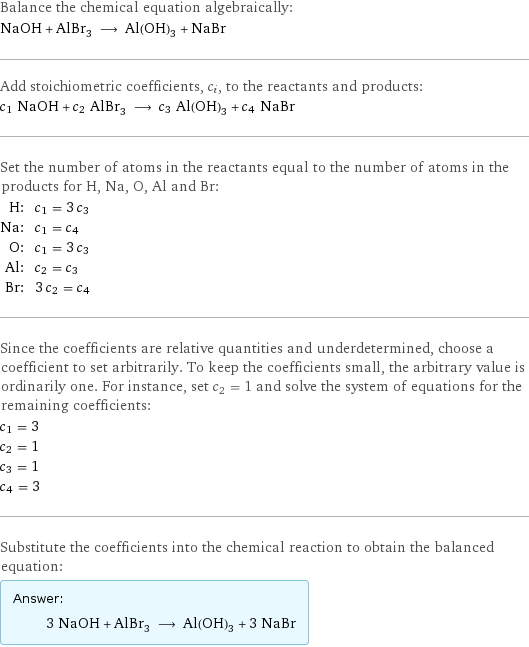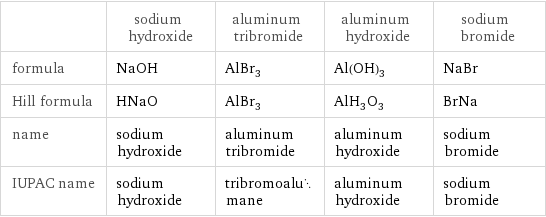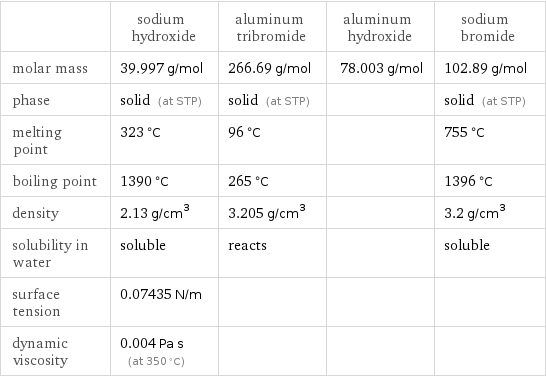Input interpretation

NaOH sodium hydroxide + AlBr_3 aluminum tribromide ⟶ Al(OH)_3 aluminum hydroxide + NaBr sodium bromide
Balanced equation

Balance the chemical equation algebraically: NaOH + AlBr_3 ⟶ Al(OH)_3 + NaBr Add stoichiometric coefficients, c_i, to the reactants and products: c_1 NaOH + c_2 AlBr_3 ⟶ c_3 Al(OH)_3 + c_4 NaBr Set the number of atoms in the reactants equal to the number of atoms in the products for H, Na, O, Al and Br: H: | c_1 = 3 c_3 Na: | c_1 = c_4 O: | c_1 = 3 c_3 Al: | c_2 = c_3 Br: | 3 c_2 = c_4 Since the coefficients are relative quantities and underdetermined, choose a coefficient to set arbitrarily. To keep the coefficients small, the arbitrary value is ordinarily one. For instance, set c_2 = 1 and solve the system of equations for the remaining coefficients: c_1 = 3 c_2 = 1 c_3 = 1 c_4 = 3 Substitute the coefficients into the chemical reaction to obtain the balanced equation: Answer: | | 3 NaOH + AlBr_3 ⟶ Al(OH)_3 + 3 NaBr
Structures

+ ⟶ +
Names

sodium hydroxide + aluminum tribromide ⟶ aluminum hydroxide + sodium bromide
Equilibrium constant
![Construct the equilibrium constant, K, expression for: NaOH + AlBr_3 ⟶ Al(OH)_3 + NaBr Plan: • Balance the chemical equation. • Determine the stoichiometric numbers. • Assemble the activity expression for each chemical species. • Use the activity expressions to build the equilibrium constant expression. Write the balanced chemical equation: 3 NaOH + AlBr_3 ⟶ Al(OH)_3 + 3 NaBr Assign stoichiometric numbers, ν_i, using the stoichiometric coefficients, c_i, from the balanced chemical equation in the following manner: ν_i = -c_i for reactants and ν_i = c_i for products: chemical species | c_i | ν_i NaOH | 3 | -3 AlBr_3 | 1 | -1 Al(OH)_3 | 1 | 1 NaBr | 3 | 3 Assemble the activity expressions accounting for the state of matter and ν_i: chemical species | c_i | ν_i | activity expression NaOH | 3 | -3 | ([NaOH])^(-3) AlBr_3 | 1 | -1 | ([AlBr3])^(-1) Al(OH)_3 | 1 | 1 | [Al(OH)3] NaBr | 3 | 3 | ([NaBr])^3 The equilibrium constant symbol in the concentration basis is: K_c Mulitply the activity expressions to arrive at the K_c expression: Answer: | | K_c = ([NaOH])^(-3) ([AlBr3])^(-1) [Al(OH)3] ([NaBr])^3 = ([Al(OH)3] ([NaBr])^3)/(([NaOH])^3 [AlBr3])](../image_source/8a193ef83ee3ab768eaa848d5a52a380.png)
Construct the equilibrium constant, K, expression for: NaOH + AlBr_3 ⟶ Al(OH)_3 + NaBr Plan: • Balance the chemical equation. • Determine the stoichiometric numbers. • Assemble the activity expression for each chemical species. • Use the activity expressions to build the equilibrium constant expression. Write the balanced chemical equation: 3 NaOH + AlBr_3 ⟶ Al(OH)_3 + 3 NaBr Assign stoichiometric numbers, ν_i, using the stoichiometric coefficients, c_i, from the balanced chemical equation in the following manner: ν_i = -c_i for reactants and ν_i = c_i for products: chemical species | c_i | ν_i NaOH | 3 | -3 AlBr_3 | 1 | -1 Al(OH)_3 | 1 | 1 NaBr | 3 | 3 Assemble the activity expressions accounting for the state of matter and ν_i: chemical species | c_i | ν_i | activity expression NaOH | 3 | -3 | ([NaOH])^(-3) AlBr_3 | 1 | -1 | ([AlBr3])^(-1) Al(OH)_3 | 1 | 1 | [Al(OH)3] NaBr | 3 | 3 | ([NaBr])^3 The equilibrium constant symbol in the concentration basis is: K_c Mulitply the activity expressions to arrive at the K_c expression: Answer: | | K_c = ([NaOH])^(-3) ([AlBr3])^(-1) [Al(OH)3] ([NaBr])^3 = ([Al(OH)3] ([NaBr])^3)/(([NaOH])^3 [AlBr3])
Rate of reaction
![Construct the rate of reaction expression for: NaOH + AlBr_3 ⟶ Al(OH)_3 + NaBr Plan: • Balance the chemical equation. • Determine the stoichiometric numbers. • Assemble the rate term for each chemical species. • Write the rate of reaction expression. Write the balanced chemical equation: 3 NaOH + AlBr_3 ⟶ Al(OH)_3 + 3 NaBr Assign stoichiometric numbers, ν_i, using the stoichiometric coefficients, c_i, from the balanced chemical equation in the following manner: ν_i = -c_i for reactants and ν_i = c_i for products: chemical species | c_i | ν_i NaOH | 3 | -3 AlBr_3 | 1 | -1 Al(OH)_3 | 1 | 1 NaBr | 3 | 3 The rate term for each chemical species, B_i, is 1/ν_i(Δ[B_i])/(Δt) where [B_i] is the amount concentration and t is time: chemical species | c_i | ν_i | rate term NaOH | 3 | -3 | -1/3 (Δ[NaOH])/(Δt) AlBr_3 | 1 | -1 | -(Δ[AlBr3])/(Δt) Al(OH)_3 | 1 | 1 | (Δ[Al(OH)3])/(Δt) NaBr | 3 | 3 | 1/3 (Δ[NaBr])/(Δt) (for infinitesimal rate of change, replace Δ with d) Set the rate terms equal to each other to arrive at the rate expression: Answer: | | rate = -1/3 (Δ[NaOH])/(Δt) = -(Δ[AlBr3])/(Δt) = (Δ[Al(OH)3])/(Δt) = 1/3 (Δ[NaBr])/(Δt) (assuming constant volume and no accumulation of intermediates or side products)](../image_source/a1fee20d84be8ff7549d4bbc25976340.png)
Construct the rate of reaction expression for: NaOH + AlBr_3 ⟶ Al(OH)_3 + NaBr Plan: • Balance the chemical equation. • Determine the stoichiometric numbers. • Assemble the rate term for each chemical species. • Write the rate of reaction expression. Write the balanced chemical equation: 3 NaOH + AlBr_3 ⟶ Al(OH)_3 + 3 NaBr Assign stoichiometric numbers, ν_i, using the stoichiometric coefficients, c_i, from the balanced chemical equation in the following manner: ν_i = -c_i for reactants and ν_i = c_i for products: chemical species | c_i | ν_i NaOH | 3 | -3 AlBr_3 | 1 | -1 Al(OH)_3 | 1 | 1 NaBr | 3 | 3 The rate term for each chemical species, B_i, is 1/ν_i(Δ[B_i])/(Δt) where [B_i] is the amount concentration and t is time: chemical species | c_i | ν_i | rate term NaOH | 3 | -3 | -1/3 (Δ[NaOH])/(Δt) AlBr_3 | 1 | -1 | -(Δ[AlBr3])/(Δt) Al(OH)_3 | 1 | 1 | (Δ[Al(OH)3])/(Δt) NaBr | 3 | 3 | 1/3 (Δ[NaBr])/(Δt) (for infinitesimal rate of change, replace Δ with d) Set the rate terms equal to each other to arrive at the rate expression: Answer: | | rate = -1/3 (Δ[NaOH])/(Δt) = -(Δ[AlBr3])/(Δt) = (Δ[Al(OH)3])/(Δt) = 1/3 (Δ[NaBr])/(Δt) (assuming constant volume and no accumulation of intermediates or side products)
Chemical names and formulas

| sodium hydroxide | aluminum tribromide | aluminum hydroxide | sodium bromide formula | NaOH | AlBr_3 | Al(OH)_3 | NaBr Hill formula | HNaO | AlBr_3 | AlH_3O_3 | BrNa name | sodium hydroxide | aluminum tribromide | aluminum hydroxide | sodium bromide IUPAC name | sodium hydroxide | tribromoalumane | aluminum hydroxide | sodium bromide
Substance properties

| sodium hydroxide | aluminum tribromide | aluminum hydroxide | sodium bromide molar mass | 39.997 g/mol | 266.69 g/mol | 78.003 g/mol | 102.89 g/mol phase | solid (at STP) | solid (at STP) | | solid (at STP) melting point | 323 °C | 96 °C | | 755 °C boiling point | 1390 °C | 265 °C | | 1396 °C density | 2.13 g/cm^3 | 3.205 g/cm^3 | | 3.2 g/cm^3 solubility in water | soluble | reacts | | soluble surface tension | 0.07435 N/m | | | dynamic viscosity | 0.004 Pa s (at 350 °C) | | |
Units
